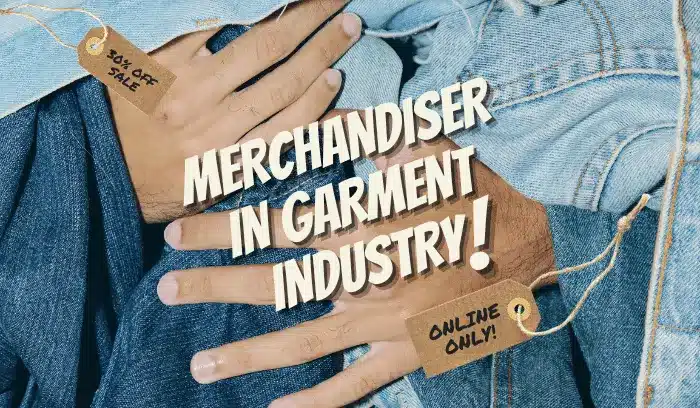A Merchandiser in Garments Industry plays a pivotal role in linking manufacturers and buyers. They ensure products meet market demands and trends.
Navigating the dynamic world of fashion, a Merchandiser in Garments Industry stands as a key figure in the success of apparel brands and manufacturers. Their expertise not only lies in current fashion trends but also in predicting future demands.
By closely working with designers, production teams, and buyers, they help in crafting products that resonate with the target audience. Their responsibilities extend beyond the selection of fabrics and designs; they also play a crucial part in pricing, marketing strategies, and inventory management. With the global fashion industry evolving rapidly, the role of a Merchandiser has become more critical than ever, making them indispensable in ensuring that the right product reaches the right consumer at the right time.
FlowChart Of Merchandiser
- Market Research: Identifying trends and customer needs.
- Product Development: Designing garments based on market research.
- Sampling: Creating prototypes of the designed garments.
- Sample Approval: Getting client approval on the samples.
- Cost Estimation: Calculating the production costs.
- Pricing: Setting the price for the garments.
- Order Placement: Receiving and confirming orders from clients.
- Production Planning: Scheduling and organizing the production process.
- Raw Material Sourcing: Acquiring fabrics, trims, and other necessary materials.
- Production: Manufacturing the garments.
- Quality Control: Checking the produced garments for defects.
- Packaging: Preparing the approved garments for shipping.
- Shipping: Sending the finished products to the clients.
The Role Of A Merchandiser In Garments Industry
The garments industry thrives on creativity and efficiency. Central to this ecosystem is the merchandiser, a pivotal figure who transforms designs into tangible products. Their role is multifaceted, encompassing design interpretation, cost management, and quality control.
Connecting Design To Production
A merchandiser acts as a bridge between the creative team and the factory floor. They translate fashion designs into production-friendly formats. This translation involves:
- Selecting suitable fabrics and trims
- Creating detailed product specifications
- Ensuring designs are feasible for manufacturing
They collaborate closely with designers and factories. This ensures that each garment is produced as envisioned.
Balancing Cost And Quality
Merchandisers ensure garments meet budget and quality standards. They are responsible for:
- Negotiating cost-effective deals with suppliers
- Conducting quality assurance checks at various stages
- Maintaining a balance between superior quality and cost efficiency
By managing these factors, merchandisers contribute to the brand’s reputation and profitability.
Essential Skills For Effective Merchandising
The garments industry thrives on effective merchandising. Merchandisers bridge the gap between the creative and the commercial sides of fashion. They ensure products meet consumer demands and arrive at the right place and time. To excel, they need a specific set of skills.
Strong Communication Abilities
Communication is key in merchandising. Merchandisers often act as a link between suppliers, designers, and retailers. They need to clearly express ideas, updates, and concerns. This ensures everyone works towards the same goal. Good communication avoids misunderstandings and delays.
Negotiation And Cost Management
Merchandisers must master negotiation. They deal with suppliers to get the best prices. This affects the product’s final cost and the company’s profit. Cost management skills help keep projects within budget, ensuring a successful line that appeals to both the company and its customers.
Understanding Of Fashion Trends
Knowing what’s in and what’s out is crucial. Merchandisers must stay ahead of fashion trends. This knowledge allows them to select products that will sell. They analyze market data and customer feedback. This helps predict future trends.
- Communicate effectively with all stakeholders
- Negotiate better deals and manage costs efficiently
- Stay updated with fashion trends to ensure product relevancy
Market Analysis And Consumer Behavior
Market analysis and consumer behavior is crucial for merchandisers in the garments industry. These insights help predict trends, meet customer needs, and stay ahead of the competition. In this section, we dive into the strategies for identifying who will buy the products and how competitors influence the market.
Identifying Target Audiences
Knowing the right audience is key for success. Merchandisers must recognize who their customers are. This involves looking at age, gender, income, and fashion preferences. They use this data to create products that appeal directly to their consumers. Tools like surveys, social media analysis, and purchase data help in this process.
- Age: Determines fashion trends
- Gender: Influences types of garments
- Income: Affects pricing strategies
- Preferences: Guides design choices
Analyzing Competitor Strategies
Staying competitive means knowing what others do. Merchandisers examine their competitors’ pricing, marketing, and product quality. They look for gaps in the market where they can stand out. This could mean offering unique designs, better quality, or more attractive pricing. They keep a close eye on bestsellers and customer reviews from other brands.
| Competitor Analysis Focus | Benefits |
|---|---|
| Pricing | Helps in setting competitive prices |
| Marketing | Identifies successful campaigns |
| Product Quality | Ensures high standards |
| Customer Reviews | Provides feedback for improvement |
Supplier Relationship Management
In the garments industry, Supplier Relationship Management (SRM) is crucial. It ties directly to a brand’s success. Efficient SRM ensures a stable supply chain. This leads to better product quality and timely deliveries. Let’s delve into how merchandisers can excel in SRM.
Cultivating Trustworthy Vendor Networks
Maintaining a trustworthy vendor network is key for any merchandiser. Strong relationships with suppliers can lead to better deals and reliable service. Here’s how merchandisers can build these vital connections:
- Regular communication with suppliers
- Visits to production sites
- Feedback loops for continuous improvement
- Transparent negotiations and agreements
These steps help in creating a robust vendor network. Merchandisers can rely on them for quality materials.
Ensuring Timely Delivery And Quality
Timely delivery and quality are non-negotiable in the garments industry. Merchandisers play a vital role in making this happen. They must:
| Task | Benefit |
|---|---|
| Track production schedules | Prevents delays |
| Perform quality checks | Ensures high standards |
| Maintain open communication | Solves issues quickly |
| Negotiate realistic timelines | Builds supplier trust |
By focusing on these tasks, merchandisers can guarantee product excellence.
Technology Integration In Merchandising
The world of merchandising in the garments industry is evolving. Technology integration plays a key role. It makes processes faster and more efficient. Let’s explore how technology reshapes this field.
Leveraging Software For Inventory Management
Managing inventory can be complex. But, software solutions make it easier. They track products from arrival to sale. This ensures that stock levels are optimal. It reduces waste and increases sales.
- Real-time tracking keeps stock levels accurate.
- Automated reordering prevents stockouts.
- Data analytics highlight trends for better decision-making.
Adopting Sustainable Practices Through Tech
Sustainability is vital in today’s world. Technology helps companies be more eco-friendly. It optimizes resources and reduces waste. This not only helps the planet but also boosts brand image.
- Material tracking tools ensure sustainable sourcing.
- Energy-efficient machinery lowers carbon footprint.
- Recycling programs are easier to manage with specialized software.
Product Development And Lifecycle Management
The journey of a garment from concept to market is intricate. This journey is known as Product Development and Lifecycle Management. It’s a crucial phase where merchandisers shine. They turn sketches into sellable clothing. This process has several key stages. Let’s dive into two vital ones.
Overseeing Sample Creation
Creating a sample is like bringing a drawing to life. Merchandisers must make sure each detail is perfect. They work with designers and factories. Their goal is to create a sample that looks good and can be made again easily.
- Fabric selection: They choose materials that look good and last long.
- Size and fit: They check if the garment fits well on different body types.
- Color accuracy: They ensure colors match the designer’s vision.
- Quality control: They inspect each sample for any issues.
Managing Production Timelines
Time is fashion money. Merchandisers keep everything on schedule. They plan each step so that clothes are ready for sale when needed.
| Phase | Task | Deadline |
|---|---|---|
| Design Approval | Finalize the garment’s look | Week 1 |
| Material Sourcing | Order fabrics and trims | Week 3 |
| Production | Start making the clothes | Week 5 |
| Quality Check | Inspect each item carefully | Week 8 |
| Shipping | Send clothes to stores | Week 10 |
Merchandisers use calendars and software to track these steps. They talk to teams every day. Their work ensures that customers find new clothes in stores on time.
Pricing Strategy And Profitability
The right pricing strategy in the garments industry is crucial. It ensures profits while attracting customers. Merchandisers must balance costs, value, and competition. This balance affects a brand’s success. Let’s delve into the specifics.
Costing And Pricing Of Garments
Costing is the first step. It involves calculating the total expense to produce an item. This includes materials, labor, overheads, and other costs. Merchandisers must understand all these elements.
Pricing follows costing. It sets the selling price. This price must cover costs and include a profit margin. Several factors influence garment pricing. These are market demand, brand positioning, and competitor pricing.
| Cost Component | Description |
|---|---|
| Materials | Fabrics, trims, accessories |
| Labor | Cutting, sewing, finishing |
| Overheads | Rent, utilities, equipment |
| Other Costs | Transport, duties, packaging |
Maximizing Margins While Maintaining Quality
Profit margins must be high enough for sustainability. Yet, quality cannot suffer. Balancing these is key. Merchandisers should employ smart strategies to achieve this.
- Efficient Production: Streamline processes to reduce waste.
- Bulk Purchasing: Order larger quantities for better prices.
- Direct Sourcing: Obtain materials from the source to cut costs.
- Technology: Use modern machinery for consistent quality.
Remember, a strong relationship with suppliers helps. It can lead to better deals and quality materials. Also, continuous market analysis is essential. It helps to adjust pricing strategies effectively.
Crisis Management And Problem-solving
Crisis Management and Problem-Solving are vital in the garment industry. Merchandisers face challenges daily. They must be quick thinkers. Their decisions can save the day. This section highlights key strategies for overcoming common crises.
Handling Supply Chain Disruptions
Supply chain disruptions can halt production. Merchandisers must act fast. They need solid backup plans. Building strong relationships with multiple suppliers is key. This ensures steady material flow. Diversification minimizes risk. Regular communication with vendors is essential. It helps identify potential issues early. Merchandisers should maintain an inventory buffer. This prepares for unexpected delays.
Navigating Market Volatility
Market volatility is unpredictable. Merchandisers must stay informed. They should analyze market trends constantly. Adapting to changing demands is crucial. Flexibility in design and production helps. This allows quick response to trends. Close collaboration with sales teams is beneficial. It ensures alignment with market needs. Financial strategies such as hedging can protect profits. Risk management tools are important for stability.
Continuing Education And Industry Trends
The garment industry moves fast. Merchandisers must keep up. They must learn always. New trends appear all the time. Customers change their minds often. Merchandisers must watch these changes. Education never stops in this field. Let’s dive into how ongoing learning and adapting to trends matter.
Staying Ahead With Ongoing Learning
Knowledge is power in the garment industry. Merchandisers must learn new skills. They should attend workshops and webinars. Online courses help too. Many platforms offer fashion and business courses. These are good for merchandisers. They teach about new fabrics and technologies. They show how to use data in decision-making. This keeps merchandisers sharp.
- Attend fashion trade shows
- Subscribe to industry publications
- Join professional networks
- Learn from online tutorials
Adapting To Shifts In Consumer Preferences
Trends change like the wind. Merchandisers must watch the market. Social media shows what people like. Online surveys can tell what customers want. Stores track what sells and what sits. This data helps merchandisers. They must pick the right styles and colors. They must choose what will sell. Sustainability is big now. People want eco-friendly clothes. Merchandisers must know this.
| Year | Trend | Consumer Preference |
|---|---|---|
| 2021 | Athleisure | Comfort and style |
| 2022 | Bold Prints | Statement pieces |
| 2023 | Eco-Fashion | Sustainability |
Networking And Relationship Building
In the garments industry, Merchandisers play a key role. Networking and relationship building are their tools. Good connections can lead to better deals, insights, and opportunities. Let’s explore how to excel in these areas.
Attending Trade Shows And Events
Trade shows and industry events are goldmines for Merchandisers. These gatherings bring together suppliers, buyers, and experts. They are perfect for meeting new contacts and learning about trends.
- Find events relevant to your niche.
- Prepare a list of people you want to meet.
- Carry enough business cards.
- Follow up with new contacts post-event.
Building A Strong Professional Network
A strong network provides support, advice, and business leads. Start with colleagues and industry acquaintances.
- Join professional groups online and offline.
- Engage in industry forums.
- Connect on social platforms like LinkedIn.
- Offer help to others to build goodwill.
Remember, strong relationships often lead to successful business ventures.
Performance Metrics For Merchandisers
In the garments industry, merchandisers play a crucial role. They make sure products meet quality and style demands. To succeed, they follow certain performance metrics. These metrics help them do better. Let’s dive into these metrics.
Key Performance Indicators (KPIs)
Merchandisers track their success with Key Performance Indicators (KPIs). KPIs show how well they work. Here are some important ones:
- Delivery Time: How fast products reach stores.
- Quality Control: How many products pass quality checks.
- Cost Efficiency: Spending less money to make products.
- Customer Satisfaction: Happy customers mean good work.
- Inventory Management: The right amount of stock is key.
Measuring Success And Identifying Areas For Improvement
KPIs help merchandisers see where they shine and where they need to get better. To measure success, they use tools and data. They look at:
- Reports on sales and customer feedback.
- How often do they meet their deadlines.
- The quality of products they make.
By checking these areas, merchandisers find ways to improve. They work on being faster, making better products, and pleasing customers. This helps them grow in their careers.
Conclusion
Embracing the role of a merchandiser in garment industry is pivotal for success. These professionals bridge design and production, ensuring trends meet market demands. Their strategic influence shapes the fashion landscape, making their expertise invaluable. As we’ve explored, their multifaceted position is the cornerstone of a thriving apparel sector.
Read More:
Top 8 Role and Responsibilities of Merchandiser
10 Different Types of Samples Use in Garments Industry
Pre Production Meeting in Garments Industry: Easy Overview
Frequently Asked Questions
What Is A Garment Merchandiser’s Role?
A garment merchandiser oversees product development, from design to production. They coordinate between designers, manufacturers, and buyers. They aim to ensure the timely delivery of quality garments that meet market trends and customer demands.
How Does One Become A Garment Merchandiser?
To become a garment merchandiser, one typically needs a relevant degree in fashion merchandising or textile management. Gaining experience through internships or entry-level jobs in the fashion industry is also crucial. Strong communication and analytical skills are essential.
What Skills Are Essential For A Merchandiser?
A successful merchandiser must possess excellent communication, negotiation, and organizational skills. They need to be adept in trend analysis, and decision-making and possess a good of the fashion market. Creative thinking and problem-solving abilities are also vital.
Why Is Merchandising Important In Garments Industry?
Merchandising is crucial as it directly impacts sales and profitability. Effective merchandising ensures that the right product is available at the right time and place, appealing to customers and meeting their expectations, which drives sales and brand loyalty.



